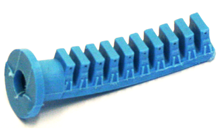Introduction
Bellows-type soft actuators are a common architecture that creates asymmetric motion by unfolding the excess material in the bellows. Compared to fiber-reinforced actuators where the elastomer material must strain to create motion, this unfolding approach places less strain on the material, which can increase the longevity of the actuator and lead to lower operating pressures. Bellows-type actuators also have the advantage that certain geometries can support bi-directional bending by alternating pressurized fluid and vacuum. Furthermore, fiber-reinforcements can be incorporated into bellows-type actuators to increase the actuator’s operating pressure and output force, and reduce its radius of curvature when actuated.
One of the most challenging aspects of fabricating a bellows-type soft actuators is molding the inner geometry. The high aspect ratio features renders any rigid core mechanically constrained and can lead to damage to the core and the actuator body during demolding. Bobak et al. used a two-step molding technique where one-half of the bellow was molded and then bonded to the other half [Adv Funct Mater. 2014]. However, this introduces a materially weak seam along the actuator’s entire perimeter and becomes the source of most actuator failures. Marchese et al. present a method where dissolvable cores are used to define the inner bellow geometry; however, this is a time consuming process requiring a new core for each new actuator and time spent dissolving the core [Soft Robotics, 2014]. To overcome these challenges, I developed a patent pending fabrication method that uses reusable ‘soft cores’ and a vacuum technique for rapid core removal.
Fabrication of a Bellows-Type Soft Actuator
The first step in fabricating a bellows-type soft actuator begins with molding the soft core, which will define the bladder geometry of the final actuator. Figure 1 depicts a silicone (M4601 by Wacker Chemical) soft core molded from a 3D printed two-part mold. During this mold step, two metal rods were also co-molded with the core, and used to support and align the core in future mold steps. In the second step, a 3D printed mold that defines the outer geometry of the soft actuator is prepared by applying mold release to all surfaces as well as to the soft core (Fig. 2). Then the polymer (Smooth-Sil 950 by Smooth On) for the bellows-type actuator can be poured into both halves of the mold (Fig. 3). Note that in this particular mold design, pins were added along the bottom of the mold to create through-holes at the top of each bellow peak. These features serve as anchor points to add reinforcements, bridging materials, and other functions to the actuator. In the fourth step, the soft core is inserted into the mold, and rods are gently pushed into alignment slots built into the mold (Fig. 4). The two halves of the mold are brought together and clamped (Fig. 5). Once the polymer has cured, the part can be removed from the mold (Fig. 6). In this example, the rods extend beyond the end of the actuator, which upon removal introduces two small holes at the end of the actuator. These can be plugged with a small amount of silicone glue (e.g. Sil-Poxy by Smooth On). This step can be eliminated by cantilevering rods from one end of the mold to create an actuator with a closed end. In the seventh step, I used a novel application of vacuum pressure to remove the soft core from the actuator body (Fig. 7). A flange molded at the open end of the actuator body is used to create an air-tight seal with the open end of a tubular vacuum chamber. When vacuum is applied, the actuator interior is subject to atmospheric pressure, while the actuator’s outer surface is subject to vacuum. This creates a pressure differential that inflates and stabilizes the actuator body to allow the operator to pull out the core. Figure 8 depicts the undamaged, soft core removed from the actuator and ready for reuse. In the final assembly steps, the flange is cut off, and a 3D printed fitting is glued into the open end.

